 Last Month Fairfax Connector hosted a series of public meetings to discuss major changes to the bus network in Fairfax County associated with the opening of the Silver Line Phase 1 metro. The idea is that regions that currently run long length bus routes (an expensive system to maintain) will have shorter, quicker service to Wiehle Avenue and Tysons Corner rail stations. The plans demonstrate that with the savings in operation cost new assets can be purchased for increasing the number of routes in many previously unserved or under served areas. The plan also showed many areas where bus services will be extended into more residential and less urban neighborhoods in an effort to provide access to transit for residents who are close to stations, but would otherwise have to drive and park.
Last Month Fairfax Connector hosted a series of public meetings to discuss major changes to the bus network in Fairfax County associated with the opening of the Silver Line Phase 1 metro. The idea is that regions that currently run long length bus routes (an expensive system to maintain) will have shorter, quicker service to Wiehle Avenue and Tysons Corner rail stations. The plans demonstrate that with the savings in operation cost new assets can be purchased for increasing the number of routes in many previously unserved or under served areas. The plan also showed many areas where bus services will be extended into more residential and less urban neighborhoods in an effort to provide access to transit for residents who are close to stations, but would otherwise have to drive and park.
All of this is great in concept. The vast majority of attendees at each of the half dozen meetings were pleased with bus routes. However, many were concerned by the duration of operation, limited to rush hour, for most of the routes modified.
Bus services rarely (very rarely) run in profits. To some extent it is understood that buses run in areas of a region that train transit can’t reach, due to the lack of population triggers that necessitate rail service. To some extent running in deficit for bus service is an unavoidable occurrence in order to provide access to elderly and low income residents, and is counter-balanced by the often unvocalized, and intangible savings to road maintenance and construction through the removal of cars from roads.
Just because a bus service will ultimately run via subsidization doesn’t mean we should be content to let waste and inflexibility be the reason why.
The Fairfax Connector annual budget is approximately $99.7 million, of which approximately $20 million is attained from fares. Let’s assume that the Connector attains a very impressive $10 million in advertisement on its buses annually (if this is true then congrats). The total subsidization, including routine capital improvements and inventory renewal, is approximately $69.7 million annually. This equates to $8.31 per bus mile operated of subsidy, with a total operation of 8,384,000 miles. A significant amount of this subsidy also addresses overhead costs, which are necessary in order to operate oversight, management, and maintenance contracts. However, much of this cost, perhaps a majority, comes from rigid fleet sizing.
Fairfax Connector only runs 35′ buses and 40′ buses, the type that you see in central urban areas around the world. These buses carry about three dozen passengers when fully loaded. In some corridors(Columbia Pike, Gallows Road, and Reston to Dulles Toll Road) these buses do operate full during peak hours. However peak hours only constitute 40% of the bus operating day, and the vast majority of routes operate far below 35 passengers per bus. In fact the average County-wide is 1.3 passenger miles per bus mile.

That is correct, we are routing buses on average that carry LESS than the average car.
All is not doom and gloom. While many of the longer routes that route in low density neighborhoods are bringing that average down, areas of higher density and walkability average far greater. Estimates in parts of Reston, Gallows, and Annandale average closer to 3 passenger miles per bus mile.
So why don’t people in low density areas ride the bus? Are they afraid? Is there a stigma? Time and time again the answers come back, I can’t get there and ultimately it doesn’t save me time. If a person has to walk for 10 minutes to get to a bus stop just to wait for a bus for 10 minutes, they are frankly better off driving elsewhere. And if that person feels in danger by crossing major roads with minimal pedestrian access, the likelihood is reduced even further.
Inherently buses route through major corridors. This works well in urban areas where high density developments directly abut major roads, but in neighborhoods that are isolated from these roads it becomes a barrier for most residents to get to where the buses can get to.
Why don’t buses go where the people are?
Physical constraints on the large buses remove most subdivision and neighborhood roads from being viable for routes. In fact most neighborhoods have fought against large buses coming down small roads where cars are parked due to the risk of property damage to vehicles, as well as noise and exhaust pollution. If you want solutions to transportation needs via transit then you can’t just say “well those people can’t be provided access”, especially when those subdivisions are home to most of the County’s population.
The size of the bus can be made more efficient, diverse, and flexible. All of these issues could be simply addressed by removing this idea that 22′ buses (many of which come with attractive bodies and alternative fuel sources) are inferior to 35′ and 40′ Goliaths which don’t meet most resident’s needs.
How about a case study?

